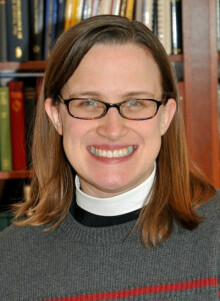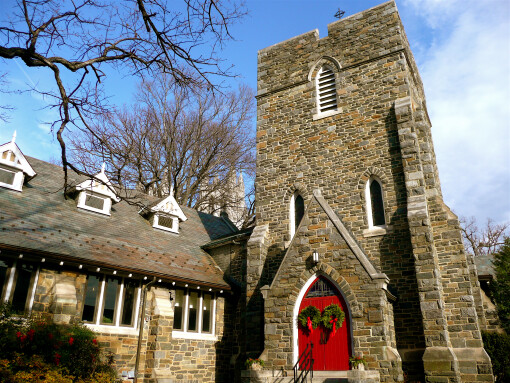What New Life Looks Like

Series: Easter
Speaker: The Rev'd Emily Griffin
We’re alive. Yes, I know what the message of Easter is supposed to be – that Christ is alive, that he is risen. And he is. But so are we. As Paul reminds us in Romans, “We have been buried with him by baptism into death, so that, just as Christ was raised from the dead, so we too might walk in newness of life.” The tricky part is – it’s hard to know sometimes what new life looks like.
Just ask the women at the tomb. In the other Gospels, they either get clear instructions – or they get an appearance of the risen Christ. But not here – here Luke delays the big reveal. New life happens in stages; it’s a process that takes time. It’s something the women need to walk into. At first, it looks like…well, absence. There’s a giant hole where the One they loved used to be, and absence is hard to interpret. It’s briefly perplexing, and then it’s just terrifying.
Next, they get the confirmation that they’re not going to find the living among the dead, that if they’re going to find new life – they’re going to have to leave the tomb. That can be harder than it sounds. The darkness of the tomb can be pretty comforting. You’re given the space and time you need to grieve; you’re surrounded by your memories, by things your loved one left behind. Folks aren’t expecting very much of you. It’s tempting to stay there, to let the darkness enfold you – to delay new life as long as possible. Why? Because whatever new life looks like, it’s precisely that – it’s new. It doesn’t look exactly like the old life; it doesn’t feel the same. It expects new things of you; you’re expected to walk into a future you can’t see yet and trust that what you’re walking toward is worth the effort it takes to get there.
In the case of our women at the tomb, they’re not left completely without guidance. They’re encouraged to look back first, to remember the past but in a different way, to hear things that fear and grief couldn’t let them hear before. No, they can’t change the past or the loss, but they can bring other memories to the foreground. They can rearrange the pieces and maybe find new things they didn’t see before. They can learn over time to tell their story differently and perhaps find new life in the retelling.
And then just when they have that notion down, the women start to tell their new story – and they’re not believed. In this instance, there are some obvious reasons why. They’re women and not men. The patriarchy was alive and well. Also, they’re followers but not official apostles. And to be fair, they haven’t actually seen the risen Christ yet. They’re still at the beginning of their walk to new life.
But there are some less obvious reasons as well. Even if they had seen the risen Christ, it would have been their experience – and some experiences can’t be easily shared. Grief takes different shapes, and we can’t force people to accept what new life looks like for us. We each need to find it for ourselves. Sometimes all we can do is point people to where we’ve found it and trust God to take it from there.
Fortunately, we have some examples of what new life can look like. We heard them in our readings this morning. It turns out that what starts as a formless void can lead to unspeakable beauty and mind-blowing variety. What begins as a valley of dry bones can turn into a vast living, breathing multitude. It doesn’t happen all at once, of course; if these passages tell us anything, it’s that new life is a process that reveals itself over time.
Sometimes we have the luxury of watching it all unfold, but most of the time it’s something we need to walk into. For those in Zephaniah’s time, new life meant a long walk home – but that’s not always what it looks like. For the ancient Israelites just out of slavery in Egypt, new life wasn’t about going home. It was about finding a new home, one they’d never seen before and could barely imagine. For them, new life at first looked like a sea of unpassable water. Then after a way was made out of no way, it looked like darkness – with just enough light to see the next step. They couldn’t see the other side when they started their walk on dry ground. It was only when they reached the shore that they could look back and see how they’d been delivered. And even then, their new life was just beginning. Freedom would take a lifetime to live into.
So it with us. The freedom we’re given in Christ – freedom from fear, freedom from the powers of sin and death, the freedom we’re promised at baptism – it can take a lifetime to live into. At first, it might just mean listening to those who point to life beyond the tomb. We might not be ready to leave the tomb just yet. Then it might mean looking back for a while before we’re ready to look ahead. We might need to hear some other stories of new life before we can see a new way to tell ours – before we’re ready to add new chapters. And then, when we’re finally ready to move forward – we might not know exactly where we’re going or how we’re going to get there. We might need to walk when we feel like running. We might need to cross some uncharted territory when we’d prefer more familiar roads. We’ll definitely need to find some new companions along the way. The good news, of course, is that we’re not walking a single step alone. Christ is with us in every step - through each death to new life. He’s alive today, and praise God - so are we. Amen.
 Welcome to St. Alban’s Church! Every Sunday, and most days in between, people gather in this place to worship, to learn, to grow, to share the joys and struggles of our lives, and to seek God’s grace in the midst of our lives. We do not come because we have it all figured out, but because we are seeking light on the way. We come as we are and welcome one another.
Welcome to St. Alban’s Church! Every Sunday, and most days in between, people gather in this place to worship, to learn, to grow, to share the joys and struggles of our lives, and to seek God’s grace in the midst of our lives. We do not come because we have it all figured out, but because we are seeking light on the way. We come as we are and welcome one another.

